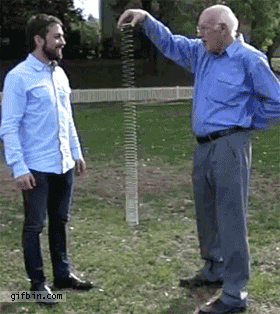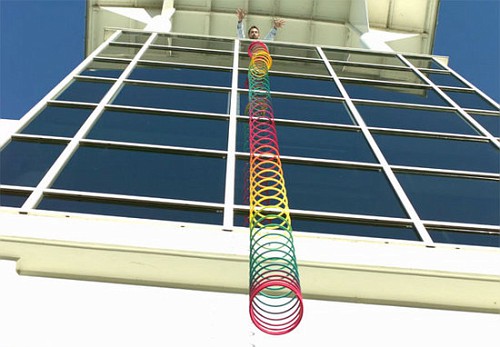
Posted on 10/04/2012 4:04:07 PM PDT by jwsea55
Watching this video, I have to ask, do we really understand gravity? When we release an object from our hands, it falls. Right? Not always? Or at least, not right away?
Veritasium has put some pretty cool videos to explain how science and physics work. They have been working with slinkies on a number of videos (and you thought your kid didn’t have any potential at 3 years old), this video seems to capture the essences of their work.
So listening to a couple of science guys explain this, does this give one a solid enough understanding why that darn bottom of the slinky doesn’t move? OK, I get the propagating communication of information thing, and that gravity has a constant force on the center of gravity but when I step back from all that, why doesn’t that slinky’s bottom move? Jim Caldwell
That conclusion is disputed, and I think most physicists operate on the basis that gravity changes don't propagate faster than light. The contrary "proof" that "delta gravity" (changes in gravity) are propagated instantaneously throughout all of spacetime depends on an impossibility, that the mass of the sun is able to drop "instantly," resulting in an "instant" change in the path of the earth through spacetime.
The paths of observed celestial objects tracks the predictions that flow from the speed of gravity being the same as the speed of light.
As for the slinky experiment, one can use classical (Newtonian) physics or engineering, disregarding all relativistic corrections, to explain the motions of the various parts.

I still find it fascinating that the slinky's bottom, essentially, doesn't start moving downward until the end. Even with a compressing center of mass, the slinky is so perfectly designed the energy in the tension equals the force of gravity.
The true explanation can only be found in God's humor.
thanks
perfect!

I would say this differently: The slinky is a helical spring suspended from one end, so the tension force at any point along the spring is exactly what is necessary to support that part of the spring which is below that point.
In other words, it is not a coincidence that the force exactly balances gravity initially; it is the natural position of the spring, having the lowest potential energy.
It's fascinating to consider what would happen if a slinky were extended between two points along a horizontal friction-free surface, like an ice rink, and then one end of the slinky is released. My guess is that we would see a similar behavior, with the loose end collapsing toward the other end and a transition between collapsed coils and coils which are undisturbed from their initial positions.
Differently from the vertical case, the horizontal slinky would initially exhibit identical spacing between coils along its entire length.
We need somebody with a slinky, a high-speed camera, and an ice rink.
Sounds right. Correct me if I'm wrong, but isn't it that the bottom isn't falling as much as it is accelerating upwards at the same rate the top is falling down? Makes it look like the bottom isn't moving.
Looks cool. Conceptually it’s not tough, the slinky spring tension moves toward compressed, so when stretched then dumped into free fall the bottom is being pulled by gravity AND the top thus it doesn’t move.
Interesting that you used that example. I had lunch with friend today. One of the "practically" smartest people one could meet in life. Engineer by training, brilliant at math but had a knack for communication and realized he could make more money in sales than in engineering. Long story short, he ended up buying one of the companies he worked for. It was a steel fabricator. The company did a lot tension steel.
Much of what you wrote about he was working out quickly in his head.
We started talking about grav forces and then we got talking about the exact horizontal example you mentioned above, "friction" free surface--ice--and restraining one end of the slinky while releasing the other.
You two are so close in what you each said. Since he had such a practical background of manufacturing tension steel, he really keyed in on the tensional relationship between each coil "loop" and force necessary to keep apart from the adjoining loop. This will remain same until it is acted upon.
He also brought up the question, if the slinky is stretched three stories and someone grabs a hold of it at some intermediate point, say somewhere in the second story, nothing should change in the tensional values below, even if the slinky is released above.
To bad science wasn't taught by guys like you in high school.
I hope you can read some of the other posts. It has been a very interesting thread. William Tell, Organic and others have done an amazing bit of analysis.
Look to the pendulum, it is there you will find your answer grasshopper....(partiality anyway).??
You win.
I was fortunate enough to have had some pretty good teachers, starting with a science teacher in sixth grade.
His hobby was inflating balloons with natural gas from the science room, tying pre-addressed postcards to them, and releasing them to see how far they could travel.
During the demo, we naturally wanted to learn more about the natural gas. The teacher demonstrated how the gas was flammable by holding a match to the bottom of the balloon he was holding.
You should describe this act to your friend and see if he can anticipate the outcome. The balloon failed at the bottom, releasing the flammable gas. The collapsing balloon accelerated the gas past the match, then the teacher's hand, and then the teacher's arm. The sheet of flame burned all the hair off the teacher's arm. We learned a lot that day. Science is fun.
Oooops...I got so hungry trying to figure this out, I ate the damn grasshopper. Sorry. :-))
Wasn't your first post was that damn krinkled up slinky we faught as a kid? Hopefully there are no psychology people in the thread. They may think there may be something more to this. :-))
Tomorrow's thread will bring Serenity Now.

You can get a good night sleep!
Learned a lot on this one.
You should describe this act to your friend and see if he can anticipate the outcome. The balloon failed at the bottom, releasing the flammable gas. The collapsing balloon accelerated the gas past the match, then the teacher's hand, and then the teacher's arm. The sheet of flame burned all the hair off the teacher's arm. We learned a lot that day. Science is fun.
Too funny. Can just picture that. I know just who I will ask to hold the balloon. He's got zero sense of humor. That in and of itself will be humorous. If chemistry labs were about blowing things up, I am sure boys would pay more attention.
Perhaps those memories are what haunted me. ;)
Not all Slinkys are in perfect free fall; some look like Schrödinger's Cat finally free from his superposition of states.
I am not sure which thread I have enjoyed more, this one or the 2 year old surfing (which also came from my friend Jim's other site 2 Year Old Stoked. Blessed to have a friend like him.) That video is just pure joy!
Very cool!
Looks like the bottom of the Slinky was waiting for the rest of the mass to catch up with it as it fell.
Of course, Slinky WAS invented by an engineer. :)
Disclaimer: Opinions posted on Free Republic are those of the individual posters and do not necessarily represent the opinion of Free Republic or its management. All materials posted herein are protected by copyright law and the exemption for fair use of copyrighted works.